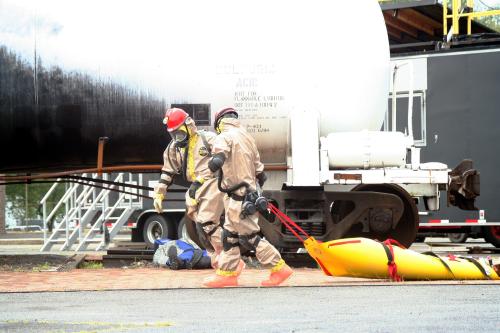National Guard exercises Homeland Response Force
| DMNA Home page | More News Stories |
Train Derailment and Chemical Spill Provides Scenario to Test Chemical, Biological and Radiological Response Team
Story by: Master Sgt. Corine Lombardo - JFHQ- New York
Dated: Fri, Aug 9, 2013
VALHALLA, N.Y. - Nearly 600 National Guard Soldiers and Airmen from New York and New Jersey joined forces to exercise techniques they would implement when called to assist first responders and health officials.
It was a simulated catastrophe, but it was taken seriously by the roughly 400 National Guard Soldiers and Airmen from New York and New Jersey who converged at the Westchester County Division of Emergency Services Fire Training Center to conduct Homeland Response Force training exercise, August 8-11.
Their task is to detect, identify, assess and render-safe an area exposed to hazardous materials and decontaminate people and property exposed to chemical, biological, radiological or nuclear (CBRN) materials resulting from an attack or incident.
The Homeland Response Force or HRF consists of nearly 600 Soldiers and Airmen of the National Guard with expertise in search and extraction of Disaster victims, incident site security, decontamination, medical treatment and command and control.
"The scenario is a train derailment with a chemical spill, but regardless of the type of incident, our team is ready to step in and assist local responders," said Maj. Fred McCoy, The New York National Guard’s CBRN deputy commander.
Past scenarios for training the emergency responders have included earthquakes, truck chemical spills, and terrorist attacks on buildings.
The individual scenario may vary but the skills the team’s Soldiers and Airmen use remain the same, McCoy said.
Each element of the team goes through specialized training and conducts individual training exercises throughout the year. According to McCoy, the HRF exercise enabled all components of the team to come together and practice as one entity.
The exercise was designed to foster increased dialogue between regional firstresponders and other state and federal response agencies.
For members of the1156th Engineer Company, located in Kingston, the exercise gave them an opportunity to exchange techniques and procedures for extracting and evacuating casualties with Westchester County firefighters, McCoy said.
"During a real incident it’s likely we will be working side-by-side localresponders, so learning how they operate is as important as practicing what we do," McCoy said.
Additional members of the HRF include:
• The 104th Military Police Battalion Headquarters based in Kingston, N.Y., who provide command of the CBRN response elements at the incident site;
• A decontamination element from the 222nd Chemical Company, based at Fort Hamilton, N.Y., who are augmented by volunteer members of the New York Guard’s 88th Brigade, based primarily in New York City;
• And Medical personnel from various New York Air National Guard units which handle the triage and transfer of casualties for civilian medical treatment.
The New Jersey National Guard’s 328th Military Police Company from Cherry Hill, N.J. the 253rd Transportation Company from Cape May Court House, N.J., the 108th Air Refueling Wing from Joint Base McGuire-Dix-Lakehurst, N.J. and the 177th Fighter Wing from Egg Harbor Township, N.J. provided the security forces for the Homeland Response Force.
Another 200 Soldiers from the 42nd Infantry Division Headquarters, based in Troy, N.Y. handle mission command and logistics tasks for the force.
During the August 8-11 exercise they set up a command post at the nearby at the New York National Guard’s Camp Smith Training Site in Cortlandt Manor.
The HRF is aligned with Region II of the Federal Emergency Management Agency, supporting efforts in New York, New Jersey, Puerto Rico and the U.S. Virgin Islands.
The unit provides governors with a response capability to assist civilian first responders in saving lives and mitigating suffering in response to a chemical, radiological or biological incident.
"Training our Soldiers and first responders before a disaster strikes is a top priority when it comes to keeping New Yorkers safe," Governor Andrew M. Cuomo said.
"Recent years have shown us the need to prepare for the unthinkable or unlikely, and exercises like this are an important step toward building a world-class emergency response network that is ready for any crisis," Cuomo added.
The National Guard sourced HRF is one of ten units established by the Department of Defense to assist or relieve state officials and local first responders in dealing CBRN attacks and incidents across the United States.
The team trains under Defense Department guidelines to respond within a 6-12 hour window to local authorities after a CBRNE or other hazardous materials incident requiring assistance from federal military resources.
URL: https://dmna.ny.gov/news/?id=1376315623
216.73.216.182
Page Last Modified: Mon, Aug 12, 2013




